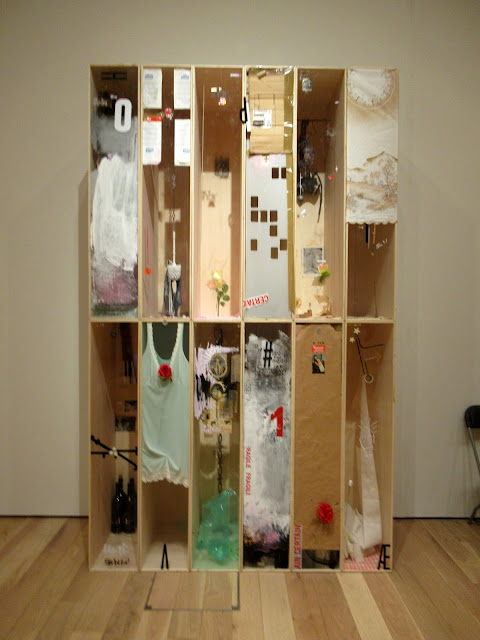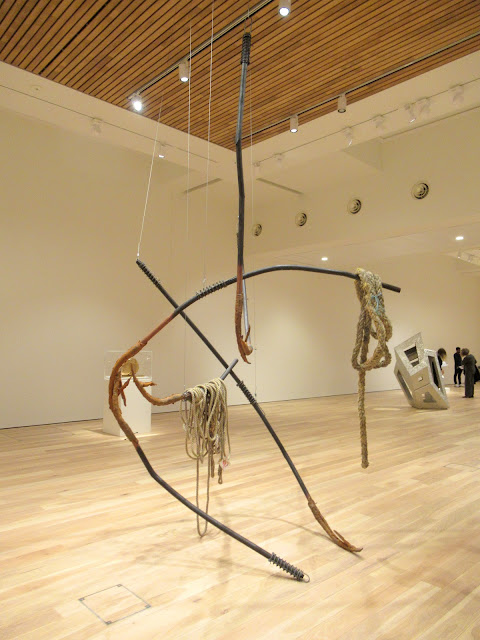The work of 23 artists who have contributed to and shaped the development of British sculpture over the last century. Titled Phantom Sculpture, the exhibition takes as its starting point the writing of Mark Fisher, cultural theorist and philosopher: '... the 21st century is oppressed by a crushing sense of finitude and exhaustion. It doesn't feel like the future. Or, alternatively, it doesn't feel as if the 21st century has startd yet. We remain trapped in the 20th century'.
With this quote in mind, Phantom Scultpture proposes that history is under constant reappraisal, none more so than by artists working today. The artists included in the exhibition mine their own histories as well as interrogating those that have been widely accepted. They create space to allow for new and emerging ideas to generate ghosts, traces and phamtons of one artist's practice in another.
Joseph Buckley, Crystal Landlord, 2023, (plastic, formica, MDF)
Virgin Variations explores ideas of sexuality, religion, gender and disability and their impact on individuals and society. Built to resemble school lockers, each wooden cabinet is arranged in an orderly format decorated with everyday objects from paper and plastics, to trinkets and clothing to reflect the artificiality of the feminine in society. There is a level of voyeurism present. Although personal objects are presented, there remains a veil of anonymity, there are no names of the objects' owners.
Rachel Whiteread, Untitled (Silver Pallet), 2021, (lacquered silver)
Floating above the boundless waves of the ocean, the empty barrels in Phillip Lai's Drunken Sailor illustrate physical immersion and disorientation whilst highlighting the economies at play in the material world. Lai frequently employs everyday objects such as containers in his work to explore the relationship between objects and humans' dependence on objects for sustenance and survival.
Mona Hatoum, Peraventm, 2008, (black finished steel)
Hatoum explores the conflicts and contradictions of our world. Born in Beirut to a Palestinian family Hatoum examines ideas of race and Western institutional power structures in her work, often using grids or geometric forms to refer to systems of control within society. Since the 1980s, she has focused on installation and sculptural work and uses household objects as a starting point. Whilst the objects maintain their familiarity, they are altered in a way that appears uncanny. At first glance, Paravent resembles a room divider commonly seen in changing rooms or hospitals but a more detailed look reveals that it is a grater magnified to larger-than-life scale. Comical yet sinister, what may once have been perceived as a harmless grater has now been enlarged to project danger and potential harm.
Sarah Lucas, Good Thoughts - Bad Thoughts, (tights, wire, wool, boots, boxing gloves, acrylic paint, chair, bin)
A playful provocation of gender, class and sexuality. Challenging the traditional plinths of grandeur and elevating statues on a moral high ground, the artist challenges this sentiment in this sculpture. Lucas selects a bright red industrial waste bin as the base for her deconstructed female figure with splayed limbs suffocating the bulging breasts of the figure. An uncomfortable confrontation with the body, Lucas questions what it means to be human and stretches the sculptural possibility of the female body to its limits.
Rebecca Ackroyd, Carcass, Float and Residual Glare I, (from the series Singed Lids), 2019, steel epoxy resin, plaster, paraffin wax
Ackroyd is an artist who incorporates the feminine and the abstraction of objects into her work. She focuses on bridging the gap between the past and present with the ordinary and the uncanny. This sculpture forms part of the series Singed Lids which evokes the scene of an aeroplane crash, with debris and body parts scattered, as a dystopia frozen in time. The use of orange resin reflects the inferno setting the aeroplane ablaze. The crash is materialised in both a literal form in the physicality of the piece and in a metaphorical form, as an interruption in our lives.
Various ceramic techniques including sgraffito, rouletting and hand carving (referencing various African pottery traditions) are used across the clay's surface, creating repeat patterns and words.
Richard Deacon, On the Back, 2011, (aluminium and stainless steel)
Phoebe Collings-James, The Infidel, 2023, (2 ceramic vessels)
This sculpture experiments with the idea of drawing in space and placement. The aluminium and stainless steel are combined into a trapezoidal and triangular frame to reflect light and create shadows across the gallery floor.
Anthony Caro, After Emma, 1977- 82, (steel rusted, blackened and painted red)
Caro has abandoned figurative forms of sculpture to focus on the idea of 'drawing in space' and through abstract forms. He was frequently inspired by nature, preferring to work outdoors. |Instead of placing sculptures on a plinth, he placed them firmly on the ground allowing them to directly confront the viewer. The name of this sculpture is derived from Emma Lake in Saskatoon, Canada, the location of the workshop where the sculpture was created.
Dominique White, Redemption, 2022, (burnt mahogany, cast iron, forged iron, damaged rope)
Winner of the 2023 Max Mara Art Prize for Women, White weaves together ideas related to the ocean, slavery, movement and blackness to create Redemption, a sculpture inspired by the artist's family history of migration from the Caribbean to the UK. The work is made from objects associated with the sea and found materials. Mirroring a ghostly figure in mid-dane, Redemption is informed by the ongoing effects of slavery and Hydrarchy, a term coined by 17th century poet Richard Braithwaite referring to the ability of individuals to gain power over land by ruling through the instruments of water. Nautical myths are an important part of White's work with materials such as worn ropes and weathered iron, capturing ideas of preservation and decay.
Barbara Hepworth, Discs in Echelon, 1964, (bronze)
Hepworth was a proponent of 'direct carving', a technique involving working directly with the final material rather than on an initial model. The shapes in Discs in Echelon are inspired by Hepworth's childhood travels across the English countryside and connect the ancient landscape with the modern world. The mirrored surface in the work warp the viewer's perception, creating contrast between colours, light and emptiness.
Jonathan Baldock, Warm Inside, i, viii, xi, 2021, (willow, steel, cotton, wool, ceramic, raffia, latex)
Kira Freije, The Weeping Arc, 2023, (stainless steel, cast aluminium, silk, grass)
The figures in Kira Freije's sculptures create a sense of unease. They are trapped in time and reflect an era belonging to the past. The sculptures resemble ghost-like figures with expressions similar to that of a death mask. The face moulds have been cast from real people whose own faces will age and change over time, while those on the sculptures stand still in time. Although the figures appear lifelike and are almost brought to life by costumes and props, the thin wiry frame reminds the viewer of absence and the reality of their simple metallic armatures and hollowed bodies.
Warm Inside was created during the pandemic and harks back to a time of uncertainty, change and survival. The idea of survival is echoed in the textile cocoon's form as a container when woven baskets played an important role for transporting and carrying goods. The cocoon shape relays the lifetime journey between womb and tomb, and is another reference to time and endurance.



























No comments:
Post a Comment